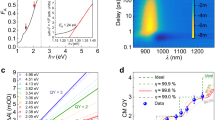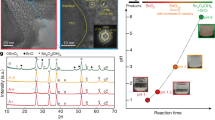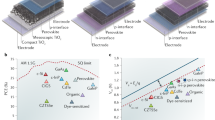Abstract
The key to improve the conversion efficiency of perovskite solar cells lies in the identification and control of different limiting factors. Both intrinsic and extrinsic losses are shown here to be detrimental on conversion efficiency well below the thermodynamic limit. The effect of varying radiative and Auger recombination processes as inevitable intrinsic losses on device performance is shown in this work. The extrinsic losses are shown to impose severe bounds on efficiency limits. Such extrinsic losses include realistic material optical properties, finite diffusion length, ideality factor, parasitic resistance, and parasite absorption. Thus, this work presents the roadmap and the possible approaches in achieving performance beyond what is currently demonstrated in the highest efficiency perovskite solar cells. Additionally, the impact of light concentration, important in Auger limited devices is investigated. Finally, the impact of Auger recombination for perovskite with finite diffusion length in a two-terminal perovskite/silicon tandem device is investigated.





Similar content being viewed by others
References
M.A. Green, A. Ho-Baillie, and H.J. Snaith: The emergence of perovskite solar cells. Nat. Photonics 8(7), 506 (2014).
R.M. Swanson: Approaching the 29% limit efficiency of silicon solar cells. In Conference Record of the Thirty-first IEEE photovoltaic Specialists Conference, Florida, 2005; p. 889.
I. Almansouri, A. Ho-Baillie, S.P. Bremner, and M.A. Green: Supercharging silicon solar cell performance by means of multijunction concept. IEEE J. Photovoltaics 5(3), 968 (2015).
M.A. Green, K. Emery, Y. Hishikawa, W. Warta, and E.D. Dunlop: Solar cell efficiency tables (version 47). Prog. Photovoltaics: Res. Appl. 24(1), 3 (2016).
E. Wei, X. Ren, L. Chen, and W.C. Choy: The efficiency limit of CH3NH3PbI3 perovskite solar cells. Appl. Phys. Lett. 106(22), 221104 (2015).
S. Agarwal and P.R. Nair: Device engineering of perovskite solar cells to achieve near ideal efficiency. Appl. Phys. Lett. 107(12), 123901 (2015).
I. Almansouri, A. Ho-Baillie, and M.A. Green: Ultimate efficiency limit of single-junction perovskite and dual-junction perovskite/silicon two-terminal devices. Jpn. J Appl. Phys. 54(8S1), 08KD04 (2015).
P. Löper, B. Niesen, S-J. Moon, S. Martin De Nicolas, J. Holovsky, Z. Remes, M. Ledinsky, F-J. Haug, J-H. Yum, and S. De Wolf: Organic–Inorganic halide perovskites: Perspectives for silicon-based tandem solar cells. IEEE J. Photovoltaics 4(6), 1545 (2014).
N.N. Lal, T.P. White, and K.R. Catchpole: Optics and light trapping for tandem solar cells on silicon. IEEE J. Photovoltaics 4(6), 1380 (2014).
C. Law, L. Miseikis, S. Dimitrov, P. Shakya-Tuladhar, X. Li, P.R. Barnes, J. Durrant, and B.C. O’Regan: Performance and stability of lead perovskite/TiO2, polymer/PCBM, and dye sensitized solar cells at light intensities up to 70 suns. Adv. Mater. 26(36), 6268 (2014).
R.K. Misra, S. Aharon, B. Li, D. Mogilyansky, I. Visoly-Fisher, L. Etgar, and E.A. Katz: Temperature-and component-dependent degradation of perovskite photovoltaic materials under concentrated sunlight. J. Phys. Chem. Lett. 6(3), 326 (2015).
W. Shockley and H.J. Queisser: Detailed balance limit of efficiency of p–n junction solar cells. J. Appl. Phys. 32(3), 510 (1961).
S. Sun, T. Salim, N. Mathews, M. Duchamp, C. Boothroyd, G. Xing, T.C. Sum, and Y.M. Lam: The origin of high efficiency in low-temperature solution-processable bilayer organometal halide hybrid solar cells. Energy Environ. Sci. 7(1), 399 (2014).
T. Tiedje, E. Yablonovitch, G.D. Cody, and B.G. Brooks: Limiting efficiency of silicon solar cells. IEEE Trans. Electron Devices 31(5), 711 (1984).
M.A. Green: Limiting efficiency of bulk and thin-film silicon solar cells in the presence of surface recombination. Prog. Photovoltaics: Res. Appl. 7(4), 327 (1999).
National Renewable Energy Laboratory: Reference solar spectral irradiance: Air Mass 1.5. http://rredc.nrel.gov/solar/spectra/am1.5/ (accessed 27 August, 2015).
P. Löper, M. Stuckelberger, B. Niesen, J.R.M. Werner, M. Filipič, S-J. Moon, J-H. Yum, M. Topič, S. De Wolf, and C. Ballif: Complex refractive index spectra of CH3NH3PbI3 perovskite thin films determined by spectroscopic ellipsometry and spectrophotometry. J. Phys. Chem. Lett. 6(1), 66 (2014).
M.A. Green, Y. Jiang, A.M. Soufiani, and A. Ho-Baillie: Optical properties of photovoltaic organic–inorganic lead halide perovskites. J. Phys. Chem. Lett. 6(23), 4774 (2015).
C. Wehrenfennig, M. Liu, H.J. Snaith, M.B. Johnston, and L.M. Herz: Homogeneous emission line broadening in the organo lead halide perovskite CH3NH3PbI3−xClx. J. Phys. Chem. Lett. 5(8), 1300 (2014).
G. Xing, N. Mathews, S. Sun, S.S. Lim, Y.M. Lam, M. Grätzel, S. Mhaisalkar, and T.C. Sum: Long-range balanced electron-and hole-transport lengths in organic–inorganic CH3NH3PbI3. Science 342(6156), 344 (2013).
S.D. Stranks, G.E. Eperon, G. Grancini, C. Menelaou, M.J. Alcocer, T. Leijtens, L.M. Herz, A. Petrozza, and H.J. Snaith: Electron-hole diffusion lengths exceeding 1 micrometer in an organometal trihalide perovskite absorber. Science 342(6156), 341 (2013).
Q. Dong, Y. Fang, Y. Shao, P. Mulligan, J. Qiu, L. Cao, and J. Huang: Electron-hole diffusion lengths >175 µm in solution-grown CH3NH3PbI3 single crystals. Science 347(6225), 967 (2015).
W. Shockley and W.T. Read: Statistics of the recombinations of holes and electrons. Phys. Rev. 87(5), 835 (1952).
R.N. Hall: Electron-hole recombination in germanium. Phys. Rev. 87(2), 387 (1952).
E. Edri, S. Kirmayer, A. Henning, S. Mukhopadhyay, K. Gartsman, Y. Rosenwaks, G. Hodes, and D. Cahen: Why lead methylammonium tri-iodide perovskite-based solar cells require a mesoporous electron transporting scaffold (but not necessarily a hole conductor). Nano Lett. 14(2), 1000 (2014).
K. Taretto, U. Rau, and J.H. Werner: Closed-form expression for the current/voltage characteristics of pin solar cells. Appl. Phys. A. 77(7), 865 (2003).
M.A. Green: Solar Cells: Operating Principles, Technology, and System Applications (Englewood Cliffs: Prentice-Hall, 1982).
S.M. Sze and K.K. Ng: Physics of Semiconductor Devices (Hoboken: John Wiley & Sons, 2006).
S.S. Hegedus and W.N. Shafarman: Thin-film solar cells: device measurements and analysis. Prog. Photovoltaics: Res. Appl. 12(2–3), 155 (2004).
J.T-W. Wang, J.M. Ball, E.M. Barea, A. Abate, J.A. Alexander-Webber, J. Huang, M. Saliba, I. Mora-Sero, J. Bisquert, and H.J. Snaith: Low-temperature processed electron collection layers of Graphene/TiO2 nanocomposites in thin film perovskite solar cells. Nano Lett. 14(2), 724 (2013).
K. Kalyanasundaram: Dye-sensitized Solar Cells (Lausanne, Switzerland: EPFL Press, 2010).
D-J. Kwak, B-H. Moon, D-K. Lee, C-S. Park, and Y-M. Sung: Comparison of transparent conductive indium tin oxide, titanium-doped indium oxide, and fluorine-doped tin oxide films for dye-sensitized solar cell application. J. Electr. Eng. Technol. 6(5), 684 (2011).
The National Center for Photovoltaics at National Renewable Energy Laboratory: Research cell efficiency Records. http://www.nrel.gov/ncpv/images/efficiency_chart.jpg (accessed 15 March, 2016).
ACKNOWLEDGMENT
The Australian Centre for Advanced Photovoltaics (ACAP) encompasses the Australian-based activities of the Australia U.S. Institute for Advanced Photovoltaics (AUSIAPV) and is supported by the Australian Government through the Australian Renewable Energy Agency (ARENA). This work is also supported by ARENA through project 2014/RND075. In addition, I. Almansouri gratefully acknowledges the financial support for this work provided by the Masdar Institute of Science and Technology.
Author information
Authors and Affiliations
Corresponding author
Rights and permissions
About this article
Cite this article
Almansouri, I., Green, M.A. & Ho-Baillie, A. The ultimate efficiency of organolead halide perovskite solar cells limited by Auger processes. Journal of Materials Research 31, 2197–2203 (2016). https://doi.org/10.1557/jmr.2016.214
Received:
Accepted:
Published:
Issue Date:
DOI: https://doi.org/10.1557/jmr.2016.214




